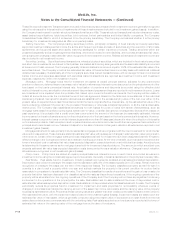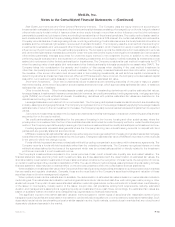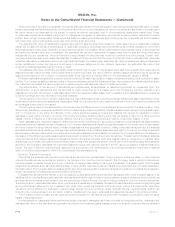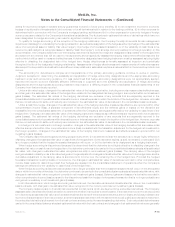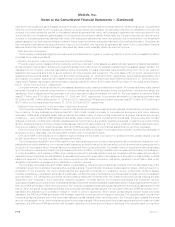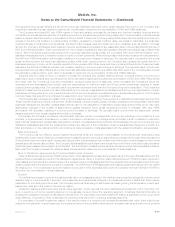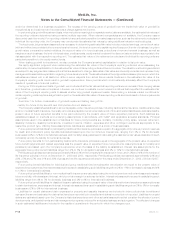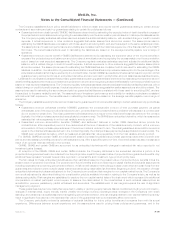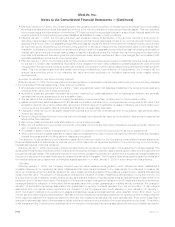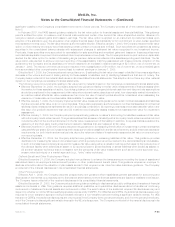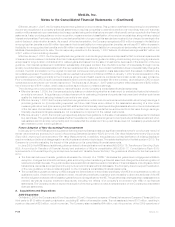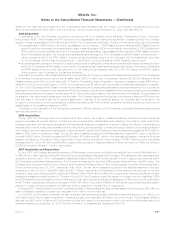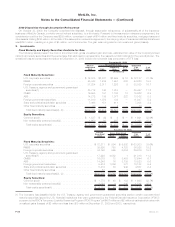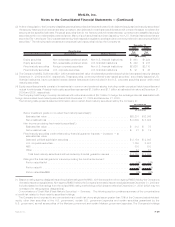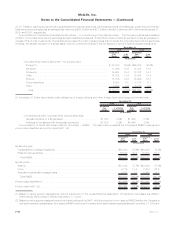MetLife 2009 Annual Report Download - page 106
Download and view the complete annual report
Please find page 106 of the 2009 MetLife annual report below. You can navigate through the pages in the report by either clicking on the pages listed below, or by using the keyword search tool below to find specific information within the annual report.Pension benefits are provided utilizing either a traditional formula or cash balance formula. The traditional formula provides benefits based
upon years of credited service and either final average or career average earnings. The cash balance formula utilizes hypothetical or notional
accounts which credit participants with benefits equal to a percentage of eligible pay, as well as earnings credits, determined annually based
upon the average annual rate of interest on 30-year Treasury securities, for each account balance. At December 31, 2008, virtually all the
obligations are calculated using the traditional formula.
The Subsidiaries also provide certain postemployment benefits and certain postretirement medical and life insurance benefits for retired
employees. Employees of the Subsidiaries who were hired prior to 2003 (or, in certain cases, rehired during or after 2003) and meet age and
service criteria while working for one of the Subsidiaries, may become eligible for these other postretirement benefits, at various levels, in
accordance with the applicable plans. Virtually all retirees, or their beneficiaries, contribute a portion of the total cost of postretirement
medical benefits. Employees hired after 2003 are not eligible for any employer subsidy for postretirement medical benefits.
The projected pension benefit obligation (“PBO”) is defined as the actuarially calculated present value of vested and non-vested pension
benefits accrued based on future salary levels. The accumulated pension benefit obligation (“ABO”) is the actuarial present value of vested
and non-vested pension benefits accrued based on current salary levels. Obligations, both PBO and ABO, of the defined benefit pension
plans are determined using a variety of actuarial assumptions, from which actual results may vary, as described below.
The expected postretirement plan benefit obligations (“EPBO”) represents the actuarial present value of all other postretirement benefits
expected to be paid after retirement to employees and their dependents. Unlike for pensions, the EPBO is not recorded in the financial
statements but is used in measuring the periodic expense. The accumulated postretirement plan benefit obligations (“APBO”) represents the
actuarial present value of future other postretirement benefits attributed to employee services rendered through a particular date and is the
valuation basis upon which liabilities are established. The APBO is determined using a variety of actuarial assumptions, from which actual
results may vary, as described below.
The Company recognizes the funded status of the PBO for pension plans and the APBO for other postretirement plans for each of its plans
in the consolidated balance sheets. The actuarial gains or losses, prior service costs and credits and the remaining net transition asset or
obligation that had not yet been included in net periodic benefit costs are charged, net of income tax, to accumulated other comprehensive
income.
Net periodic benefit cost is determined using management estimates and actuarial assumptions to derive service cost, interest cost, and
expected return on plan assets for a particular year. Net periodic benefit cost also includes the applicable amortization of any prior service
cost (credit) arising from the increase (decrease) in prior years’ benefit costs due to plan amendments or initiation of new plans. These costs
are amortized into net periodic benefit cost over the expected service years of employees whose benefits are affected by such plan
amendments. Actual experience related to plan assets and/or the benefit obligations may differ from that originally assumed when
determining net periodic benefit cost for a particular period, resulting in gains or losses. To the extent such aggregate gains or losses
exceed 10 percent of the greater of the benefit obligations or the market-related asset value of the plans, they are amortized into net periodic
benefit cost over the expected service years of employees expected to receive benefits under the plans.
The obligations and expenses associated with these plans require an extensive use of assumptions such as the discount rate, expected
rate of return on plan assets, rate of future compensation increases, healthcare cost trend rates, as well as assumptions regarding participant
demographics such as rate and age of retirements, withdrawal rates and mortality. Management, in consultation with its external consulting
actuarial firm, determines these assumptions based upon a variety of factors such as historical performance of the plan and its assets,
currently available market and industry data and expected benefit payout streams. The assumptions used may differ materially from actual
results due to, among other factors, changing market and economic conditions and changes in participant demographics. These differences
may have a significant effect on the Company’s consolidated financial statements and liquidity.
The Subsidiaries also sponsor defined contribution savings and investment plans (“SIP”) for substantially all employees under which a
portion of employee contributions is matched. Applicable matching contributions are made each payroll period. Accordingly, the Company
recognizes compensation cost for current matching contributions. As all contributions are transferred currently as earned to the SIP trust, no
liability for matching contributions is recognized in the consolidated balance sheets.
Stock-Based Compensation
As more fully described in Note 18, the Company grants certain employees and directors stock-based compensation awards under
various plans that are subject to specific vesting conditions. The cost of all stock-based transactions is measured at fair value at grant date
and recognized over the period during which a grantee is required to provide goods or services in exchange for the award. Although the terms
of the Company’s stock-based plans do not accelerate vesting upon retirement, or the attainment of retirement eligibility, the requisite service
period subsequent to attaining such eligibility is considered nonsubstantive. Accordingly, the Company recognizes compensation expense
related to stock-based awards over the shorter of the requisite service period or the period to attainment of retirement eligibility. An estimation
of future forfeitures of stock-based awards is incorporated into the determination of compensation expense when recognizing expense over
the requisite service period.
Foreign Currency
Balance sheet accounts of foreign operations are translated at the exchange rates in effect at each year-end and income and expense
accounts are translated at the average rates of exchange prevailing during the year. The local currencies of foreign operations generally are
the functional currencies unless the local economy is highly inflationary. Translation adjustments are charged or credited directly to other
comprehensive income or loss. Gains and losses from foreign currency transactions are reported as net investment gains (losses) in the
period in which they occur.
Discontinued Operations
The results of operations of a component of the Company that either has been disposed of or is classified as held-for-sale are reported in
discontinued operations if the operations and cash flows of the component have been or will be eliminated from the ongoing operations of the
F-22 MetLife, Inc.
MetLife, Inc.
Notes to the Consolidated Financial Statements — (Continued)


